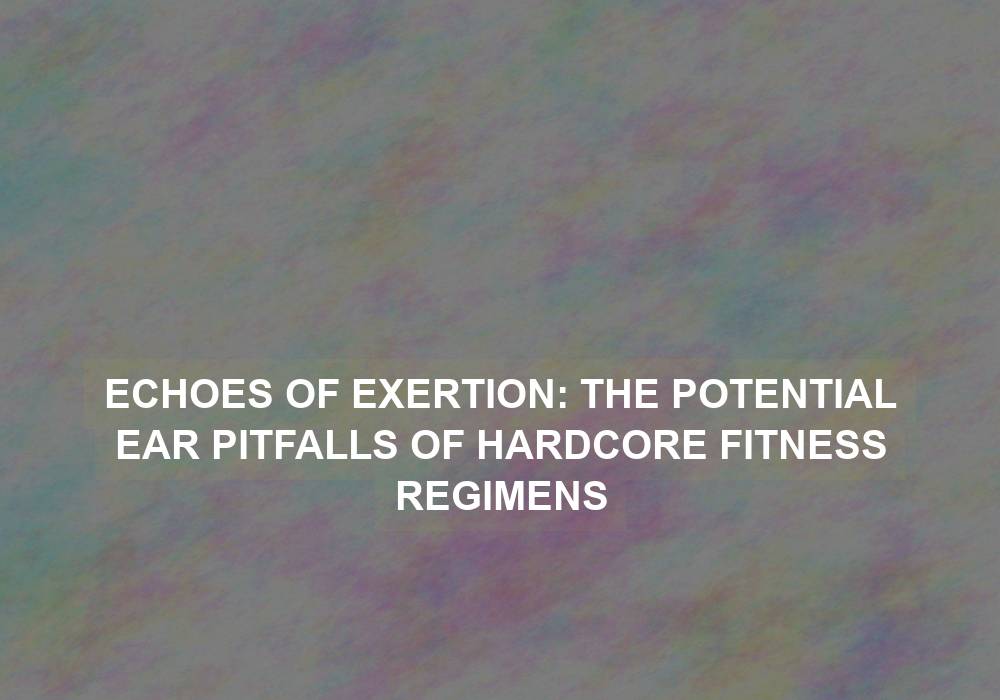In the pursuit of fitness, many individuals are drawn to hardcore training regimens that push their bodies to the limit. While such workouts can yield impressive physical results, it is important to be aware of the potential ear pitfalls that can arise from these intense fitness routines. This article aims to shed light on the possible consequences of hardcore fitness regimens on ear health, providing valuable insights for individuals striving for both physical and auditory well-being.
The Impact of Intense Exercise on Ear Health
Intense exercise can have various impacts on ear health, some of which include:
- Ear Trauma: Engaging in heavy weightlifting, intense aerobic exercises, or contact sports can increase the risk of ear trauma. Direct blows to the head or sudden impacts during these activities can result in damage to the delicate structures within the ear, leading to hearing loss or other ear-related issues.
To minimize the risk of ear trauma, individuals participating in activities with a higher risk should consider wearing appropriate protective gear. Examples of protective gear include ear guards, helmets, or headbands designed to absorb impact.
- Barotrauma: Individuals involved in activities associated with rapid altitude changes, such as skydiving or scuba diving, may experience barotrauma. This condition occurs due to unequal pressure between the middle ear and the environment, often resulting in discomfort, pain, and potential damage to the eardrum or middle ear structures.
To prevent barotrauma, it is crucial to learn and practice ear equalization techniques when participating in activities involving rapid altitude changes. This ensures that the pressure within your ears remains balanced, reducing the likelihood of damage.
- Noise-Induced Hearing Loss (NIHL): Hardcore fitness regimens often involve the use of loud music or noisy environments to enhance motivation and intensity. Prolonged exposure to high-intensity sounds can result in noise-induced hearing loss. This condition is characterized by a gradual deterioration of hearing ability and can be irreversible.
To protect against NIHL, individuals should be mindful of the noise levels during their workouts. Excessive noise exposure, especially through headphones or loud music, can lead to hearing damage. Consider using noise-cancelling headphones, adjusting volume levels to a safe range, or opting for quieter workout environments.
Preventive Measures to Safeguard Ear Health
To protect your ears from potential risks associated with hardcore fitness regimens, you can adopt several proactive measures:
1. Utilize Protective Gear:
When engaging in activities with an increased risk of ear trauma, such as contact sports or weightlifting, wearing appropriate protective gear can significantly minimize the chances of injury. Examples of protective gear include ear guards, helmets, or headbands designed to absorb impact.
2. Follow Proper Technique:
Learning and adhering to proper exercise techniques can help reduce the risk of ear trauma. Focus on maintaining good form, especially during weightlifting or exercises involving head movement. Employing correct techniques can lessen the strain on your body, including your ears.
3. Equalize Ear Pressure:
If you participate in activities involving rapid altitude changes, such as scuba diving, it is crucial to learn and practice ear equalization techniques. This ensures that the pressure within your ears remains balanced, reducing the likelihood of barotrauma.
Some effective ear equalization techniques include:
- Swallowing or yawning: These actions help to open the Eustachian tube and equalize the pressure.
- Pinching your nostrils shut and gently blowing through your nose while keeping your mouth closed.
- Using specialized ear equalization techniques taught by professionals in the field.
4. Monitor Noise Levels:
Be mindful of the noise levels during your workouts. Excessive noise exposure, especially through headphones or loud music, can lead to NIHL. Consider using noise-cancelling headphones, adjusting volume levels to a safe range, or opting for quieter workout environments.
5. Take Regular Breaks:
Engaging in intense workouts for prolonged periods without adequate rest can strain not only your muscles but also your ears. Allow your body and ears sufficient time to recover between sessions, preventing overuse and potential damage.
6. Stay Hydrated:
Maintaining proper hydration is essential for overall health, including ear health. Proper hydration ensures optimal blood flow to the ear structures, promoting their well-being and reducing the risk of injury.
7. Regular Auditory Check-ups:
Incorporating regular auditory check-ups into your healthcare routine is advisable. Consult an audiologist or an ear specialist to assess your hearing and address any potential concerns or early signs of ear damage.
By implementing these preventive measures, individuals can continue their hardcore fitness regimens while safeguarding their ear health.
Conclusion
While hardcore fitness regimens offer numerous benefits for physical fitness, it is crucial to be mindful of potential ear pitfalls that can arise from these intense training routines. Understanding the impact of intense exercise on ear health, adopting preventive measures, and seeking regular auditory check-ups can help individuals strike a balance between their fitness goals and ear well-being. Prioritizing both physical and auditory health ensures a holistic approach to overall wellness.
